Exactly fifty years ago, the first concept of the computer networks we know today as Ethernet was designed. It has evolved from a thick coaxial cable connecting computers in a single location to the most common way of connecting networks of all sizes via twisted pair and optical fibre.
According to his own recollection, Bob Metcalfe came up with the first Ethernet design on May 22, 1973. The name refers to the aether, a substance that scientists believed permeated the entire universe and allowed the propagation of electromagnetic waves. For the computer networks of the time, that aether was coaxial cable, but the network design was to be universal and allow for propagation through other media. In a way, the author also predicted the existence of technologies such as DSL or Wi-Fi on this historical sketch.
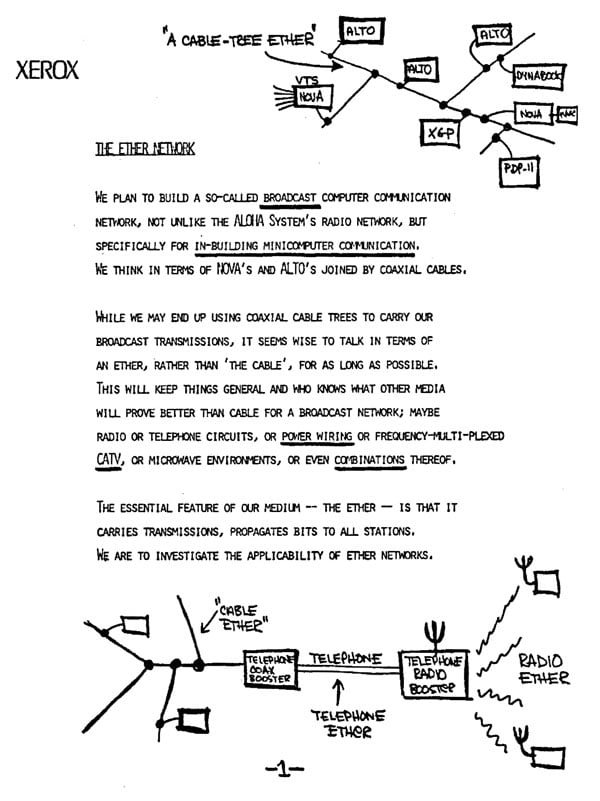
For some, the right moment is November 11, 1973, when the first prototype of an Ethernet network actually started working. The very first version worked at a then very fast speed of 2.94 megabits per second, which was increased to an even faster speed of 10 megabits per second in 1980.
All connected to one cable
The basic idea of Ethernet is to connect all computers to a single shared medium, which in the early versions was coaxial cable. The important thing was that it did not branch, but passed through from one computer to another. The cable is terminated at both ends with resistors to prevent reflections and the creation of standing waves that would interfere with communication.
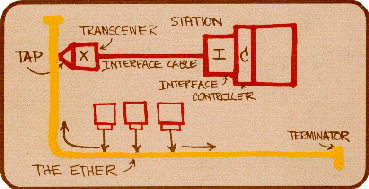
The earliest of the standards, 10Base5 also nicknamed thick Ethernet, used an external transceiver, a combination of transmitter and receiver that was punctured to connect to the running coaxial cable. This transceiver was then connected via a 15-core cable to the AUI interface of the network card.
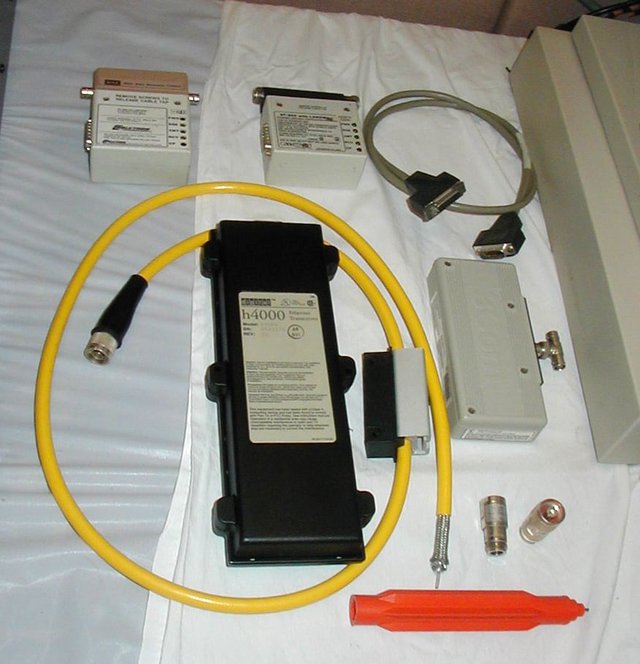
The slightly more modern 10Base2 standard used a thinner coaxial cable that connected directly to each computer via T-connector. This entailed a considerable degree of unreliability, as the cable always had to be cut and the connectors fitted to connect another station. Each connector failure or cable disconnection for another reason resulted in the entire segment being non-functional: due to the lack of a proper termination, even the individual disconnected islands were not functional.
Switching to telephone cables and star topology
It was precisely because of the low reliability of the long bus winding from one computer to another that a completely different Ethernet began to take over in the early 1990s, the one that used a star (or hub-and-spoke) topology with an active element in the middle - the concentrator or hub.
The much higher cable consumption is compensated in this case by the use of significantly cheaper twisted-pair telephone cables. The use of the existing telephone infrastructure, which also uses a star topology, was envisaged. This is still evident today in the way that the individual pairs are connected to the modular connector according to the TIA/EIA-568B standard, as well as the fact that the original Ethernet uses only two pairs and can thus be combined with the telephone line (which traditionally uses the middle two contacts) in a single cable.
| Pin | Pair | Color |
|---|---|---|
| 1 | 2 | white/orange |
| 2 | 2 | orange |
| 3 | 3 | white/green |
| 4 | 1 | blue |
| 5 | 1 | white/blue |
| 6 | 3 | green |
| 7 | 4 | white/brown |
| 8 | 4 | brown |
The hub was originally just a fairly simple electronic device that amplified the received signal and sent it to all the other ports, effectively simulating a shared medium. Unlike previous versions of Ethernet, the failure of a single link only affected the functionality of the device connected to that link; on the other hand, this topology created the potential for loops that can be very harmful even today.
Tenfold speedup
As early as 1995, the Fast Ethernet standard was introduced, which increased the already high speed of 10 megabits per second tenfold. Conceptually, it functioned identically to the existing Ethernet, but it placed greater demands on the quality of cables and active elements. The higher speed also lowered the limit on the maximum number of hubs in the path.
The introduction of Fast Ethernet was initially a difficult decision. It required replacing both the hub and all the network cards connected to it. While there were also dual-speed hubs that allowed both slow and fast network cards to be connected, devices of different speed could not communicate with each other. The simple electronics of the hub contained no memory to slow down fast signals or speed up slow signals.
The advent of bridges and switches
A device that allows speeding up or slowing down the data is called network bridge. In its simplest form, it stores the received Ethernet frame in memory and then broadcasts it to the other port. In doing so, it performs an optimisation by not sending frames to the other side whose destination address is certainly not there. This is very important, for example, for connecting network segments of different speeds, otherwise the slower side would be constantly overwhelmed by irrelevant traffic forwarded from the faster side.
The real advent of Fast Ethernet thus came only with the availability of switches, which are multi-port bridges that gradually replaced ordinary hubs. Thanks to the internal memory at each port, switches can not only efficiently connect devices of different speeds, but even filter useless traffic and parallelise mutually independent communications or offer a full-duplex connection, i.e. the ability to receive data even when other data is being sent.
This gradually removes the aether from Ethernet; there is simply no common environment in a switched network that allows the propagation of computer data. In all directions, switches only propagate frames addressed to all, previously unknown addresses, or to a specific group - this traffic is referred to as BUM traffic and is usually perceived as problematic precisely because it is propagates throughout the whole network.
Gigabit uses all wires
While at the turn of the millennium, ordinary computers could rarely handle a line at 100 megabits per second, Ethernet has gone further and introduced tenfold speedup once again. Gigabit Ethernet according to the 1000Base-T standard has achieved this speed-up without the need to increase cable quality requirements. This was very important, because Category 5e cables were installed everywhere at the time. It is very likely that the nearest cable you will find around you will be Category 5e.
Whereas Fast Ethernet used only one twisted pair for transmitting and one for receiving, Gigabit Ethernet fitted all four pairs with telephone hybrids and thus used them for bidirectional transmission. This alone increased the speed to 400 megabits per second. The next step was to remove the 4b5b encoding, which increased the speed by 25 percent, to 500 megabits per second. The use of a multi-state line code encoding two bits into a single state change then caused the final doubling to 1000 megabits per second.
Obviously, transceivers for Gigabit Ethernet are much more complex than those for Fast Ethernet (which in turn are more complex than those for conventional Ethernet). However, thanks to the massive development of electronics, Gigabit Ethernet has already become a commodity in the late noughties.
Faster and further with fibre optics
In addition to metallic cables, Ethernet also supports various optical fibers. These are most commonly used in backbone networks where the length limit of metallic cable is not sufficient. However, they can also be used for short links in data centres for speeds higher than or equal to 10 gigabits. Depending on the type of application, there is a lot of different Ethernet over fiber optic standards, differing for example in wavelength, number of fibers and their type (single-mode or multi-mode), maximum supported distance or interface of the optical module.
A special category is passive optical access networks, where several subscribers share a single fibre, which is split along the way by optical splitters. Ethernet offers a solution under the name EPON, but a large number of network operators prefer to build passive networks based on the International Telecommunication Union's competing GPON standard. Even there, however, Ethernet frames are being tunnelled.
New Ethernet can be even slower
Back in 2002, the first 10 Gigabit Ethernet was standardised. It found its application mainly in backbone networks and long routes, but the renewal of all network hardware was rather lacking. Partly because one gigabit speed is still more than sufficient for the vast majority of activities today, and partly because 10 Gigabit Ethernet no longer works with the most old Category 5e cables. Its metallic variant, 10GBase-T, is not popular because of the higher latency compared to optical links due to more advanced link coding.
However, Gigabit Ethernet runs into its limits in some specific cases. This is the case, for example, when connecting Wi-Fi access points. Thanks to the dramatic developments in wireless networking, it is now common to find situations where the theoretical data capacity of a radio interface exceeds 1000 megabits per second. Switching to 10 Gigabit Ethernet is not possible without replacing cables.
For these reasons, 2.5 Gigabit and 5 Gigabit Ethernet were later introduced. They use advanced line coding developed for 10 Gigabit Ethernet, but slowed down to work with ordinary Category 5e and Category 6 cables respectively.
To the terabit future
Fifty years on, Ethernet is still evolving towards higher speeds. One hundred gigabit connections are now quite common in peering centers, 200 and 400 gigabit speeds are gradually appearing, and a standard for 800 gigabits per second is under development. It is likely that within the next ten years, a standard will be available that transmits Ethernet frames at one terabit per second. With Ethernet frame sizes fixed in the range of 64-1518 bytes, such a speed means receiving and transmitting one frame every 0.5-1.5 nanoseconds.
Leaving aside data centres and the Internet backbone infrastructure, there is some stagnation. We are likely to see some development of 2.5 Gigabit Ethernet in connection with multigigabit offerings from Internet service providers, but in general the consumer segment is dominated by Wi-Fi and wired infrastructure is more likely to be abandoned.
Connection of the Wi-Fi access points themselves will probably be sufficient for a few more years with 2.5 Gigabit and 5 Gigabit Ethernet in corporate environments, while households will probably more and more make use completely wireless solutions like Wi-Fi mesh, where the radio interface is also used to connect access points to each other.

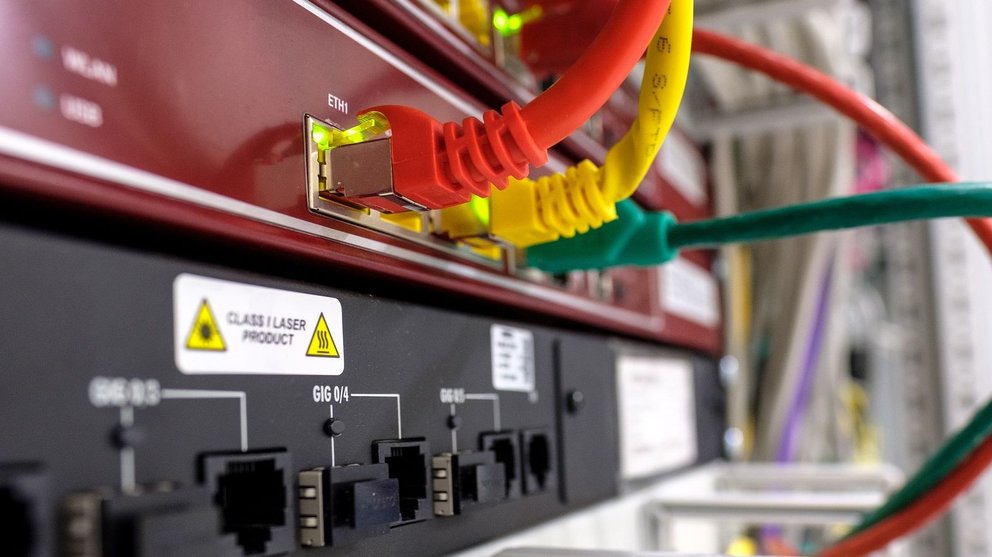

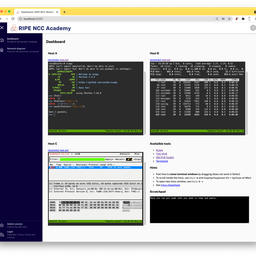
Comments 0
The comments section is closed for articles published more than a year ago. If you'd like to inform us of any issues, please contact us.